Interbike: Fuji Auric 1.1 First Ride
Originally posted on September 18, 2015 at 12:49 pmFuji is not usually the first brand that springs to mind when most riders think of mountain bikes, but full suspension has returned to the company product line and Fuji’s new Auric with M-Link suspension design just might begin to change minds.

The M-Link suspension design was first introduced on Breezer’s Supercell and Repack. Breezer is a sister brand to Fuji, so it comes as no surprise the M-Link design found its way to the relaunch of Fuji’s full suspension bikes. (Beside the long-travel Auric, Fuji also released a 120mm 29er, the Rakan.)
I rode Breezer’s Repack at Outdoor Demo and was impressed with M-Link, but found the geometry to be steep for a long-travel bike. I expected to feel much the same way about the Auric, but geometry numbers don’t always tell the full story.
While the 67-degree head angle is quite steep compared to a Nomad’s 65 degrees, a long top tube (24.6 in large) and the resulting long front center would have me guessing the Auric was at least a degree slacker than it is. Combined with not-long chainstays (17.2), great tires (Schwalbe Rock Razor and Hans Dampf) and a comfortable cockpit, I was much more at home on the trails in Bootleg Canyon than anything I’ve ridden in recent memory.

The M-Link had a best pedaling efficiency of any bike I have ridden on the Dirt Demo trails, and one of the best of any 160mm bikes I have ridden. This includes both sitting and standing pedaling. Most modern bikes are very good at seated pedaling but the bob-monster can still rear its head when up on the pedals and cranking up a steep climb.
Once the climb was over and the trailside photoshoot finished, I took off on a rolling descent. I expected the Auric to morph into a handful as my speed increased, but instead found myself riding a bike that constantly goaded me into increasing my speed. I had hit the jackpot of demo bikes: The suspension was set well for my weight; the bar width/height and stem length suited me; and the tires featured a great tread pattern and compound. This is a very rare thing.
I had a blast and actually extended my ride to get more time on the bike. Every time I get jaded from many years of doing this kind of work, something like the Auric comes along to remind me not to judge a book by its cover, or a bike by its geometry numbers. I wish I had time to shuttle up to the nearby DH trails as I have a feeling I would have liked it there, too. The Auric is a great combination of toss-it-around playfulness, pedal-ablity and some handling left in reserve for when the playfulness gets you to write a check your skills can’t match.


Parts pick on the top-o-the-line Auric 1.1 is excellent—there is nothing I would bother changing—and has a few nice touches like a Praxis chainring, MRP chain guide/bash guard and Oval Boost crankset. The other three models also looked to be thoughtfully built.
I admittedly misplaced my notebook with pricing and availability info and will update this post when I track down the numbers and dates.
We are looking to get the 29-inch, 120mm Rakan in for review. If it rides as well as the Auric, I think Fuji might significantly be upping its profile in the mountain bike world.